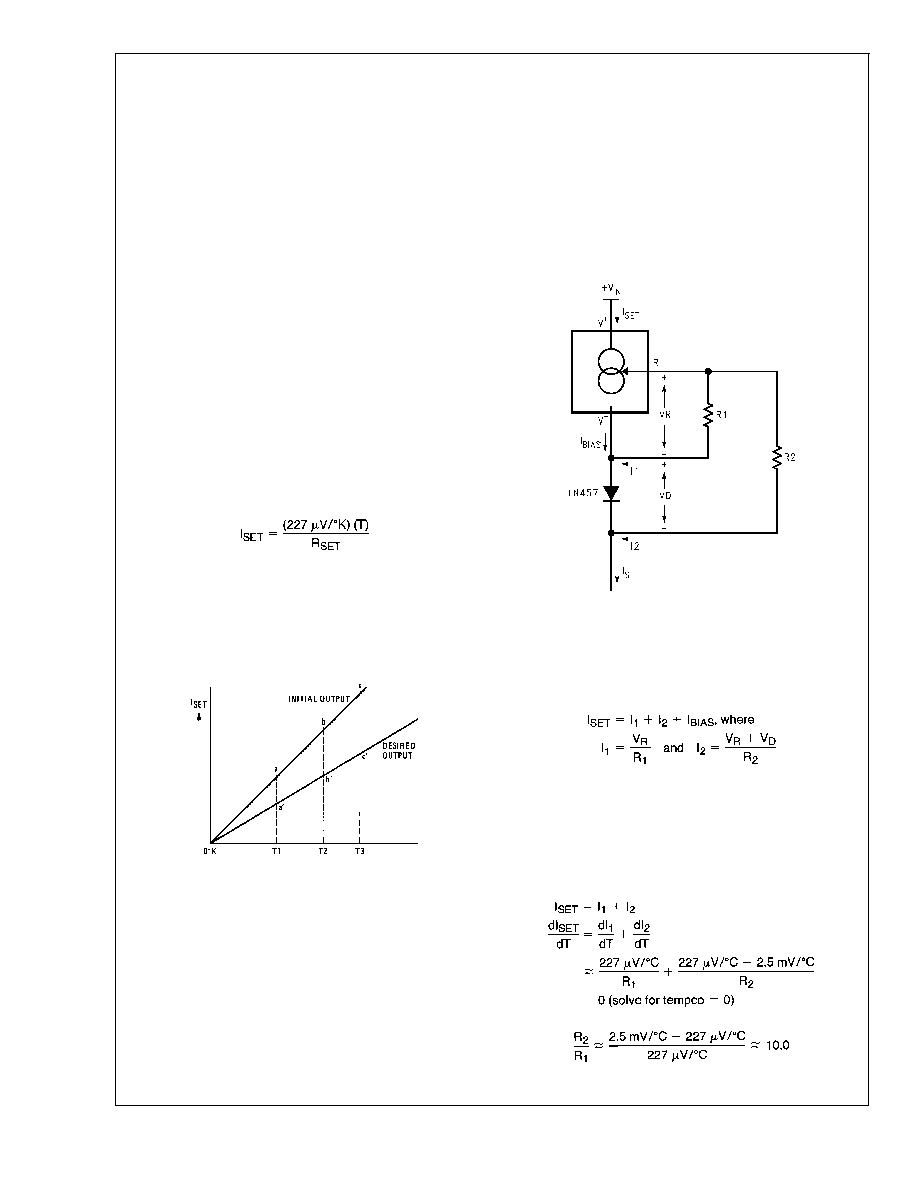- 您现在的位置:买卖IC网 > PDF目录44530 > LM334MDC (NATIONAL SEMICONDUCTOR CORP) SPECIALTY ANALOG CIRCUIT, UUC PDF资料下载
参数资料
| 型号: | LM334MDC |
| 厂商: | NATIONAL SEMICONDUCTOR CORP |
| 元件分类: | 模拟信号调理 |
| 英文描述: | SPECIALTY ANALOG CIRCUIT, UUC |
| 封装: | DIE |
| 文件页数: | 17/20页 |
| 文件大小: | 362K |
| 代理商: | LM334MDC |

Application Hints (Continued)
regulation by at least an order of magnitude. DC character-
istics (with the exception of minimum input voltage), are not
affected.
NOISE
Current noise generated by the LM134 is approximately 4
times the shot noise of a transistor. If the LM134 is used as
an active load for a transistor amplifier, input referred noise
will be increased by about 12dB. In many cases, this is
acceptable and a single stage amplifier can be built with a
voltage gain exceeding 2000.
LEAD RESISTANCE
The sense voltage which determines operating current of the
LM134 is less than 100mV. At this level, thermocouple or
lead resistance effects should be minimized by locating the
current setting resistor physically close to the device. Sock-
ets should be avoided if possible. It takes only 0.7
contact
resistance to reduce output current by 1% at the 1 mA level.
SENSING TEMPERATURE
The LM134 makes an ideal remote temperature sensor be-
cause its current mode operation does not lose accuracy
over long wire runs. Output current is directly proportional to
absolute temperature in degrees Kelvin, according to the
following formula:
Calibration of the LM134 is greatly simplified because of the
fact that most of the initial inaccuracy is due to a gain term
(slope error) and not an offset. This means that a calibration
consisting of a gain adjustment only will trim both slope and
zero at the same time. In addition, gain adjustment is a one
point trim because the output of the LM134 extrapolates to
zero at 0K, independent of R
SET or any initial inaccuracy.
This property of the LM134 is illustrated in the accompanying
graph. Line abc is the sensor current before trimming. Line
a'b'c' is the desired output. A gain trim done at T2 will move
the output from b to b' and will simultaneously correct the
slope so that the output at T1 and T3 will be correct. This
gain trim can be done on R
SET or on the load resistor used
to terminate the LM134. Slope error after trim will normally
be less than ±1%. To maintain this accuracy, however, a low
temperature coefficient resistor must be used for R
SET.
A 33 ppm/C drift of R
SET will give a 1% slope error because
the resistor will normally see about the same temperature
variations as the LM134. Separating R
SET from the LM134
requires 3 wires and has lead resistance problems, so is not
normally recommended. Metal film resistors with less than
20 ppm/C drift are readily available. Wire wound resistors
may also be used where best stability is required.
APPLICATION AS A ZERO TEMPERATURE
COEFFICENT CURRENT SOURCE
Adding a diode and a resistor to the standard LM134 con-
figuration can cancel the temperature-dependent character-
istic of the LM134. The circuit shown in
Figure 3 balances
the positive tempco of the LM134 (about +0.23 mV/C) with
the negative tempco of a forward-biased silicon diode (about
2.5 mV/C).
The set current (I
SET) is the sum of I1 and I2, each contrib-
uting approximately 50% of the set current, and I
BIAS.IBIAS is
usually included in the I
1 term by increasing the VR value
used for calculations by 5.9%. (See CALCULATING R
SET.)
The first step is to minimize the tempco of the circuit, using
the following equations. An example is given using a value of
+227V/C as the tempco of the LM134 (which includes the
I
BIAS component), and 2.5 mV/C as the tempco of the
diode (for best results, this value should be directly mea-
sured or obtained from the manufacturer of the diode).
DS005697-4
FIGURE 2. Gain Adjustment
DS005697-28
FIGURE 3. Zero Tempco Current Source
LM134/LM234/LM334
www.national.com
6
相关PDF资料 |
PDF描述 |
|---|---|
| LM1524DJ | SWITCHING CONTROLLER, 550 kHz SWITCHING FREQ-MAX, CDIP16 |
| LM1572MTCX-ADJ/NOPB | 3.2 A SWITCHING REGULATOR, 570 kHz SWITCHING FREQ-MAX, PDSO16 |
| LM1572MTCX-5.0/NOPB | 3.2 A SWITCHING REGULATOR, 570 kHz SWITCHING FREQ-MAX, PDSO16 |
| LM1572MTCX-3.3/NOPB | 3.2 A SWITCHING REGULATOR, 570 kHz SWITCHING FREQ-MAX, PDSO16 |
| LM1572MTC-3.3/NOPB | 3.2 A SWITCHING REGULATOR, 570 kHz SWITCHING FREQ-MAX, PDSO16 |
相关代理商/技术参数 |
参数描述 |
|---|---|
| LM334MX | 功能描述:基准电压& 基准电流 RoHS:否 制造商:STMicroelectronics 产品:Voltage References 拓扑结构:Shunt References 参考类型:Programmable 输出电压:1.24 V to 18 V 初始准确度:0.25 % 平均温度系数(典型值):100 PPM / C 串联 VREF - 输入电压(最大值): 串联 VREF - 输入电压(最小值): 分流电流(最大值):60 mA 最大工作温度:+ 125 C 封装 / 箱体:SOT-23-3L 封装:Reel |
| LM334MX/NOPB | 功能描述:基准电压& 基准电流 RoHS:否 制造商:STMicroelectronics 产品:Voltage References 拓扑结构:Shunt References 参考类型:Programmable 输出电压:1.24 V to 18 V 初始准确度:0.25 % 平均温度系数(典型值):100 PPM / C 串联 VREF - 输入电压(最大值): 串联 VREF - 输入电压(最小值): 分流电流(最大值):60 mA 最大工作温度:+ 125 C 封装 / 箱体:SOT-23-3L 封装:Reel |
| LM334S8 | 功能描述:IC CURRENT SOURCE 8SOIC RoHS:否 类别:集成电路 (IC) >> PMIC - 稳流/电流管理 系列:- 产品培训模块:Lead (SnPb) Finish for COTS Obsolescence Mitigation Program 标准包装:50 系列:- 功能:电流开关 检测方法:- 精确度:±10% 输入电压:1.7 V ~ 5.5 V 电流 - 输出:600mA 工作温度:-40°C ~ 125°C 安装类型:表面贴装 封装/外壳:10-UFQFN 供应商设备封装:10-UTQFN(1.4x1.8) 包装:管件 |
| LM334S8#PBF | 功能描述:IC CURRENT SOURCE 8SOIC RoHS:是 类别:集成电路 (IC) >> PMIC - 稳流/电流管理 系列:- 产品培训模块:Lead (SnPb) Finish for COTS Obsolescence Mitigation Program 标准包装:50 系列:- 功能:电流开关 检测方法:- 精确度:±10% 输入电压:1.7 V ~ 5.5 V 电流 - 输出:600mA 工作温度:-40°C ~ 125°C 安装类型:表面贴装 封装/外壳:10-UFQFN 供应商设备封装:10-UTQFN(1.4x1.8) 包装:管件 |
| LM334S8#TR | 功能描述:IC CURRENT SOURCE 8SOIC RoHS:否 类别:集成电路 (IC) >> PMIC - 稳流/电流管理 系列:- 产品培训模块:Lead (SnPb) Finish for COTS Obsolescence Mitigation Program 标准包装:50 系列:- 功能:电流开关 检测方法:- 精确度:±10% 输入电压:1.7 V ~ 5.5 V 电流 - 输出:600mA 工作温度:-40°C ~ 125°C 安装类型:表面贴装 封装/外壳:10-UFQFN 供应商设备封装:10-UTQFN(1.4x1.8) 包装:管件 |
发布紧急采购,3分钟左右您将得到回复。